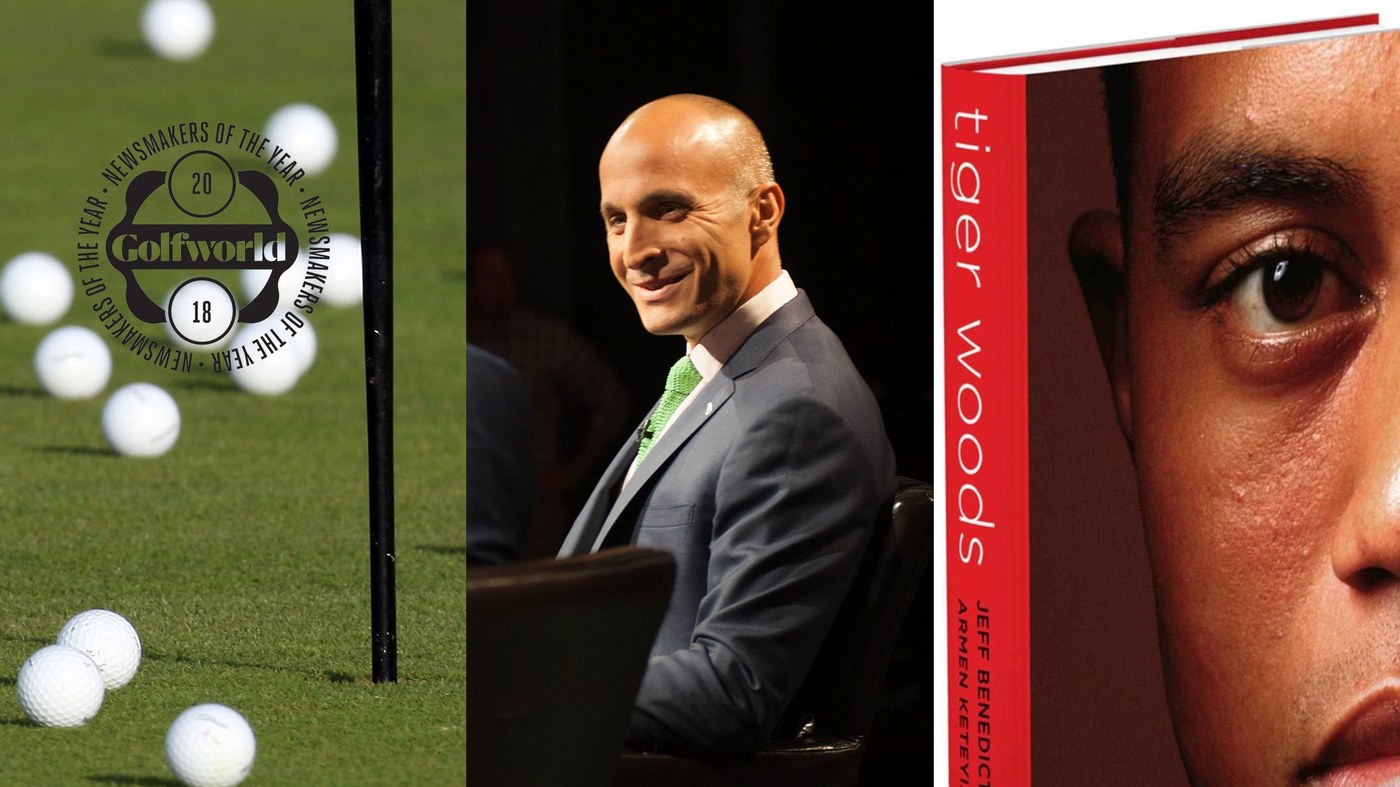Counting down our top 25 players, events and moments of the past 12 months
It’s an annual tradition at Golf World. Our “Newsmakers of the Year” package has helped cap the year in golf now for more than two decades. From our former print magazine to our current digital publication, readers have been treated to a thoughtful review of the previous 12 months, our writers returning to the players, events and moments that helped define our sport in hopes of offering a hearty encore to the season. During the next two weeks, we’ll continue the tradition by unveiling the top 25 Newsmakers of 2018—Nos. 25 to 11 from Dec. 3-7 and Nos. 10 to 1 from Dec. 10-14. There will be a few no brainers—spoiler alert: U.S. Open and PGA champion Brooks Koepka makes our list—but also some storylines that are less obvious but, we think, no less worthy of our collective appreciation. So come back each day to see who makes our list as we countdown to our No. 1 Newsmaker of 2018. —Ryan Herrington
[divider] [/divider]

Tim Clayton/Corbis via Getty Images
No. 20: Backstopping
Backstopping as a routine isn’t entirely new on the PGA Tour, but it became more out in the open in the fall of 2017. That’s when Justin Thomas confessed his right to play faster even if it means taking advantage of a ball near the hole and not waiting for it to be marked. The previously little-spoken occurrence gained more attention in June when Jimmy Walker found himself at the center of a firestorm after saying, “If you don’t like a guy you will mark anyway. If you like the guy you might leave it to help on a shot. Some guys don’t want to give help at all and rush to mark their ball. To each his own.” Fellow tour pros—Jason Day, Dustin Johnson and Luke Donald among them—took issue (rightfully so) with Walker’s stance. The most notable examples of the practice took place at the 2017-’18 season opener when Tony Finau hit a greenside bunker shot from a plugged lie as playing partner Jason Kokrak didn’t mark his ball that was next to the hole. At this year’s U.S. Open at Shinnecock Hills, there was a similar situation involving Thomas and Brian Harman. The latter led to Paul Azinger blasting the idea of helping a fellow competitor—and in turn hurting the rest of the field. There have been other occurrences as well. But given the genial relationships between many of today’s young players, and with no rule in place for something that is almost entirely intent-based, don’t expect this controversy to die down anytime soon. —Brian Wacker
[divider] [/divider]

Montana Pritchard/The PGA of America via Getty Images
No. 21: Pete Bevacqua
A golf executive switching from one big organization to another doesn’t always register with the general public, but Pete Bevacqua’s impact on the game has been bigger than most. The PGA of America CEO announced in July he would be taking a new position as president of NBC Sports Group, but only after presiding over several bold moves during his PGA tenure. In moving the PGA Championship from August to May, Bevacqua was giving the so-called fourth major a chance at a new identity. He helped secure a lucrative future for the Ryder Cup by establishing a 15-year rights deal between the PGA and NBC Sports, and set in motion a lucrative deal to move the PGA of America headquarters from South Florida to Texas. All were efforts to distinguish the PGA of America from the PGA Tour, two easy-to-confuse golf bodies with distinct missions. Bevacqua didn’t see all of those efforts come to their finish—the first May PGA is not until 2019, and the move to Texas is pending local approval—but if there’s a reason NBC wanted the charismatic Bevacqua on its team, it’s because of a proven ability to get big ideas off the ground. —Sam Weinman
[divider] [/divider]

No. 22: Tiger Woods biography
The ambitious biography, Tiger Woods, by Jeff Benedict and Armen Keteyian, delivered its share of juicy nuggets regarding the 14-time major champion—notably about his infamous sex scandal, his father’s infidelities and the particulars behind his decision to turn professional. But really what set this 512-page tome apart from the countless other profiles of Woods is how it created a three-dimensional picture of Woods’ curious existence—how he became arguably the greatest golfer of all time, but also someone who felt increasingly isolated at the height of his stardom. Of course there were elements of the book that Woods’ camp didn’t like—they cited a few small factual errors. Yet the book’s impact wasn’t so much in what it said, but in convincingly explaining why Woods ended up the way he did. —Sam Weinman
[divider] [/divider]

Stuart Franklin/Getty Images
No. 23: Shubhankar Sharma
Shubhankar Sharma’s first true introduction to golf fans on the world stage involved an actual—and awkward—introduction with one of his heroes back in March. Sharma, the surprising 36-hole leader at the WGC-Mexico Championship, approached Phil Mickelson on the practice green before the third round and was initially blown off by the five-time major champ, who mistook him for a member of the media. Mickelson wound up winning that week, but Sharma was the event’s breakout star with a performance that helped him earn a Masters invite two days later, making him just the fourth Indian golfer to tee it up at Augusta National. By year’s end, Sharma had collected the European Tour’s rookie-of-the-year award for a two-win campaign and finished 28th in the Race to Dubai. During the Open Championship, Sharma was surprisingly serenaded by a packed restaurant in Carnoustie for his 22nd birthday. Expect even more people to know who he is in 2019. —Alex Myers
[divider] [/divider]

Getty Images
No. 24: Joel Dahmen/Sung Kang
Cheating is golf’s biggest taboo. It engenders a code of omerta, a cognizance of the scarlet letter that comes with the slightest assertion. It all made Joel Dahmen’s accusation that fellow competitor Sung Kang had knowingly broken the rules at the Quicken Loans National in July the talk of the tournament. Kang, Dahmen’s final-round playing partner, found a hazard at TPC Potomac’s 10th hole. Kang believed his ball passed over the stakes; Dahmen disputed the account, alleging Kang failed to cross the water. The argument continued so long that the group behind played through. Though a rules official eventually sided with Kang—whose T-3 finish earned an Open Championship invite—Dahmen, 31, remained steadfast, taking to Twitter to air his grievance: “Kang cheated. He took a bad drop from a hazard. I argued until I was blue. I lost.” Speaking at Carnoustie, Kang defended his actions. “I did the right thing,” the 31-year-old from South Korea insisted. One silver lining from the thorny incident: Dahmen, a career journeyman, seemed galvanized by the matter, reeling off four consecutive top-15s to keep his card for 2019. As did Kang. —Joel Beall
[divider] [/divider]

Robert Laberge/Getty Images
No. 25: Bernhard Langer
Bernhard Langer, such is his consistency and resistance to aging, has turned the PGA Tour Champions season into an endless loop. For the fourth time in the last five years (and the fifth time overall), the World Golf Hall of Famer won the season-long Charles Schwab Cup and its $1 million bonus. His 14 top-10s led the tour for the seventh straight year. His earnings ($2,222,154) also led the tour for a seventh straight year. In those seven years, he’s led the tour in scoring average four times, and finished second three times, including this year. At 61, he is spotting the competition as many as 11 years in age, and is still dominating. His 38 career senior wins are seven shy of Hale Irwin’s all-time record, which seems distant, if it weren’t Langer doing the chasing. The one honour that Langer walked away with in 2018 for the first time? The PGA Tour’s Payne Stewart Award for quality of character and philanthropy. —John Strege









